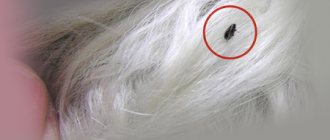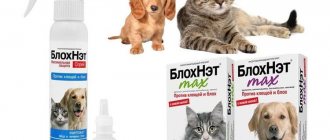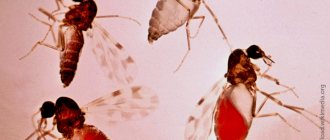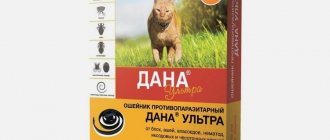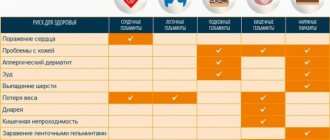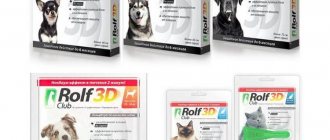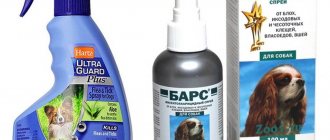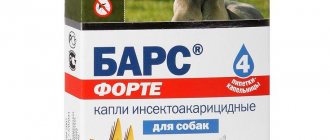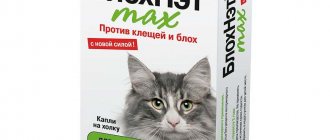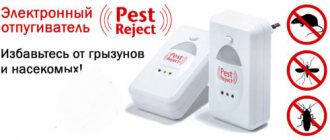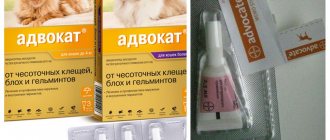Fleas are blood-sucking insects that feed on the blood of warm-blooded mammals. Common species: cat fleas (Ctenocephalides felis), human fleas (Pulex irritans), dog fleas (Ctenocephalides canis), rat fleas (Xenopsylla cheopis). These groups of parasites do not specialize in one host - the dog flea bites cats, the cat flea bites dogs, and the rat flea attacks people. Fleas are insects that undergo metamorphosis (complete transformation), including four stages of development - egg (7-14 days), larva (10-15 days), pupa (6-10 days), imago (3-18 months). Adult fleas jumping around the house and biting a dog or cat make up only 5-7% of the parasite population in the apartment, 35% are larvae, 10% are pupae, 50% are eggs. In addition, a flea does not live permanently on a pet’s body, so treatment against insects must be comprehensive: the use of drugs based on growth regulators to treat the animal + sanitary treatment of the premises.
There are many means to get rid of and prevent the appearance of parasites, the most effective of which are flea drops. They are used for the treatment and protection of sexually mature animals, kittens and puppies up to 3 months.
Types and composition of drops
Flea drops are a concentrated solution of insecticides, which are characterized by low toxicity and rapid action. The best option is drugs with juvenile effects that block the development mechanism of blood-sucking individuals at all stages:
- phenylpyrazoles (pyriprole, fipronil). The safest substances, since they preferentially inhibit GABA receptors of insects and not animals, which guarantees reliability for antiparasitic use. They work in a contact way, causing flea hyperactivity and their subsequent death;
- organophosphorus compounds (organophosphates, FOS). They are highly toxic, irritate the skin, irreversibly suppress (inhibit) enzymatic and physiological processes, accumulate in the animal’s body; with prolonged use, fleas develop resistance (resistance) to the drug and it stops working;
- pyrethroids. Safe for dogs/cats due to the absence of mutagenic and carcinogenic properties. Often cause skin reactions, do not penetrate into the blood;
- ivermectin. Affects the nervous system of fleas, prevents the maturation of eggs, pupae, larvae, and is moderately toxic. It is not recommended to treat sick, weakened animals or lactating bitches with preparations containing ivermectin;
- diflubenzuron. It inhibits the production of quinine, which protects the integument of eggs/larvae, has a weak effect on adults, and has low toxicity.
In addition to the basic insecticide, flea drops contain hormones that regulate stage-by-stage development (juvenile), synergists (enhancers) of the action of insectoacaricides, and additional substances that affect specific types of insects.
TOP 8 best drugs
The following anti-parasitic agents are the leaders on the Russian flea drops market:
- Bars forte.
- Advocate.
- IN-AP complex.
- Advantix.
- Dana Ultra.
- Stronghold.
- Inspector
- Frontline.
The drug Bars forte
The drug is manufactured by the Russian company Agrovetzashchita. Active substances: fipronil, diflubenzuron. Bars Forte protects animals from fleas and ticks for 1 month after application. The manufacturer produces drops with volumes ranging from 0.5 ml for small dogs to 5.0 ml for large dogs. Bars Forte is prescribed to puppies over 10 weeks of age without any restrictions on live weight.
Cost 339 rub.
Vetpreparat Advocate
The drug is produced by the German company Bayer. The drops destroy fleas, ixodid and scabies mites, and helminths. Active ingredients: moxidectin, imidacloprid. The volume of insecticide in pipettes varies from 0.4 to 4.0 ml.
Imidacloprid accumulates in the sebaceous glands, destroys fleas, ixodid mites, scabies mites, flies, and mosquitoes that carry dirofilaria - nematodes common to humans and dogs that live under the skin, in the eye or heart.
Moxidectin is absorbed into the blood and kills helminths, including microfilariae (Dirofilaria larvae). The lawyer protects pets from parasites for a month.
Cost 660 rub.
IN-AP product
The drug is manufactured by the Russian company Astrapharm. Praziquantel enters the blood, destroys cestodes, aversectin 1 eliminates nematodes, microfilaria (the larval stage of Dirofilaria), including. Fipronil is a contact insecticide that accumulates in the sebaceous glands.
Destroys or repels ticks, fleas, flies, mosquitoes, and other blood-sucking insects for up to one and a half months. The drug can be used for dogs older than 8 weeks and weighing more than 1 kg.
Cost 259 rub.
Advantix drops for dogs
Bayer drops are a combination of the insecticides imidacloprid and permethrin. Pyrethroid destroys the nerves of intradermal and cutaneous parasites. Imidacloprid enhances the effect of permethrin. Arthropods lose their ability to move and die. Up to 2% of the original pesticide can be absorbed into the blood, so Advantix does not harm the dog’s body.
The drops repel flies, mosquitoes and other flying insects. Parasites do not land on poisonous skin. The insectoacaricidal and repellent effect lasts 28 days. During the summer mosquito season, the drug should be used monthly, at other times - as needed.
Puppies younger than seven weeks and miniature dogs up to 1.5 kg are not treated, because the drug’s safety for such animals has not been proven.
Cost 2153 rub.
Dana Ultra drops
The drug is manufactured by the Russian company Apicenna. Fipronil and thiamethoxam block the transmission of signals from nerves to arthropod muscles. Pyriproxyfen prevents the synthesis of chitin and stops the molting of larvae. Dana Ultra protects the dog from attacks by ixodid ticks for 3 weeks, fleas, and lice for a month and a half.
The drug is used to treat otodectosis, sarcoptic mange, and demodicosis. The number of treatments on the affected area ranges from 2 to 5 at intervals of 5 to 10 days.
The drug is not used to treat puppies younger than 70 days. For animals weighing less than 5 kg, squeeze 0.4 ml onto the withers. For dogs weighing more than 40 kg, apply 4.8 ml to the skin of the back, in 3-4 places.
Cost 178 rub.
Drug Stronghold
The American company Zoetis Inc produces Stronghold insecticidal drops. The active component, selamectin, blocks the transmission of signals from nerves to muscles of arthropods and helminths.
The drug is used monthly to achieve the following goals:
- extermination of fleas;
- repelling ixodid ticks;
- treatment of sarcoptic mange, otodectosis, demodicosis;
- destruction of nematodes, including microfilariae.
Puppies are treated with Stronghold from the age of six weeks. For dogs weighing up to 2.5 kg, drops containing 6% selamectin are used.
The pipette cap is purple. Dogs weighing more than 2.5 kg are prescribed medications containing 12% of the active substance.
Cost 1064 rub.
Vetpreparat Inspector Total S
The drug is manufactured by the Russian company Ecoprom. Fipronil paralyzes the nervous system of ixodid, sarcoptic ticks, demodexes, otodectes, fleas, lice.
Moxidectin exterminates toxocara, hookworm, whipworms, and microfilariae. The drug is prescribed for the treatment of ear scabies, demodicosis, and sarcoptic mange. Inspector Total C is produced in pipettes with a volume of 0.4 to 4.0 ml. Insectoacaricidal drops retain antiparasitic activity for 4 to 6 weeks.
The drug is used to treat small breed dogs weighing up to 1 kg, puppies younger than 7 weeks.
Cost 480 rub.
Drops Frontline
The insectoacaricidal agent is manufactured by the French company Merial. Permethrin and fipronil paralyze arthropods by interrupting impulses from nerves to muscles. The synthetic substance S-methoprene is structurally reminiscent of the hormone responsible for the formation of chitin. Molting does not occur, the metamorphosis process stops, and the parasite dies before reaching maturity.
The active substances of the drug are not absorbed into the blood; they accumulate in the hairs, hair follicles, sebaceous glands, and epidermis. Frontline is distinguished by its contact action: the flea comes into contact with the treated surface and dies. The drug is allowed to be used in animals older than 8 weeks with a live weight of more than 2 kg.
Cost 627 rub.
How do flea drops work?
After application, the drops migrate through the fatty layer of the animal’s skin, the active substance is distributed, without penetrating into the bloodstream, through this layer, quickly absorbed into the hair follicles and sebaceous glands, returning over time back to the upper layers of the epidermis.
Pros:
- treating an animal with drops is more reliable and simpler than treating with an emulsion/spray; an additional bonus is savings when treating large breed dogs;
- from the point of view of ease of treatment, drops are the most reliable means of protection;
- there is no problem with determining the dosage;
- the risk of the substance getting on the mucous membranes and licking is minimal;
- long-term effect on insects - the drug actively works for 1-2 months.
Minuses:
- the drops do not begin to act immediately, it takes 12-14 hours for them to “unfold”;
- the effectiveness of the substance may be reduced due to unpredictable factors - swimming, rain, sunlight, dirt;
- the drug may not “reach” the tail, ears, or paws of the animal;
- There are real risks of overdose, especially for cats/dogs whose weight does not exceed 2 kilograms.
Drops should be counted on as a priority treatment and protection for your pet. The safest insecticides are phenylpyrazoles and pyrethroids; more toxic substances in drops can be potentially dangerous.
Features of anthelmintic drugs
At the slightest hint of unwanted guests, immediate action must be taken; fleas multiply very quickly, and they bite a person with the same appetite as their pet.
Even a domestic dog can get fleas
Washing with special shampoos containing insecticides can cause an allergic reaction, salivation and vomiting. Sprays are sprayed all over the fur, but if the dog licks itself, malaise and nausea are possible. Collars are toxic. Powders from a veterinary pharmacy are cheap, but treatment takes two weeks, and tablets will not get rid of parasites completely and will cause digestive upset
The best choice for treating a dog against ectoparasites is drops on the withers.
For better impact of drops and avoiding overdoses, the solution to the problem must be comprehensive.
Fleas jump all over the floor, so it needs to be treated with an insecticide up to half a meter in height. You will have to throw away the bedding and dog toys. Wash all fabrics in the room in hot water or steam, and vacuum the carpets. Fleas on the dog itself must be neutralized with an insecticide. The best choice for treatment is drops on the withers.
The drops instantly rid the animal of insects and are very easy to use. The price is reasonable, especially considering the long-lasting effect. They act not only on fleas, ticks, lice eaters and other parasites will also disappear.
How to choose effective drops
Choosing an anti-flea agent is a serious matter, since not all drops are equally safe and effective. Before purchasing them, you should consult with your veterinarian so that he can help you calculate the dosage depending on the weight/age of your pet.
Instructions:
- Study the range of drops in a veterinary pharmacy, paying attention to the concentration and degree of toxicity of insecticides and additional substances. The effectiveness of the drug is determined on the basis of special tests, the result of which is the “flea control” index; it should be at least 80-90%; if the figure is lower, it is better not to buy drops.
- Make sure that the expiration date has not expired.
- Consider the age of the cat or dog: drops for puppies and kittens, weakened animals, lactating/pregnant bitches have a lower content of active ingredients.
- You should not treat cats with drops for dogs and vice versa - this can lead to intoxication of the animal.
- It is not recommended to use two or more types of drops at the same time - this is fraught with a weak antagonist, suppression of transport and synergy, and an abnormal increase in toxicity. Conditionally safe options: phenylpyrazoles + pyrethroids; if necessary, carbamates can be added to the mixture.
Choose the best
There are dozens of drugs available on store shelves and veterinary pharmacies. Their cost ranges from 50 rubles per package of BlochNET, developed in Russia, to 1,500 rubles for the imported product Advocate.
It all depends on the dosage and the prestige of the manufacturers . For example, those manufactured in Germany by Bayer are much more expensive than popular domestic brands. But this does not mean that domestic ones are less effective. Imports are always more expensive; they are tied to the Euro exchange rate.
Ectoparasites can carry dangerous infections (plague bacillus, salmonella, infectious hepatitis). In order not to put yourself at risk, you need to fight parasites in pets . And easy-to-use, inexpensive and effective drops will help with this.
If you find an error, please select a piece of text and press Ctrl+Enter.
Review of popular flea drops
- Advantix. A drug based on permethrin. It has a high dosage of pyrethroids (compared to the norm, it is exceeded by the manufacturer by 5-10 times), which can cause irritation of the skin of animals and an allergic reaction in cats. Protection in 50% of cases of use. It is recommended to use simultaneously with the Kiltix collar, propoxur or fipronil sprays.
- UltraGuard. The most reliable drops with pyrethroids, safe, do not cause irritation or allergies, optimally used with an UltraGuard collar.
- Leopard. A popular domestic product, it is available in two versions - based on permethrin and fipronil. Only 20% of penetration was detected. A good inexpensive drug, but there are two points: It is recommended to purchase Leopard only from trusted suppliers in order to avoid counterfeiting; the manufacturer sometimes makes mistakes in doses in batches, so it is better to reduce processing time; for large animals, increase the dose by one pipette. Works reliably in combination with Bars spray and Kiltix collar.
- Frontline. They “break through” in 40% of cases, combined with Bars/Bolfo sprays.
- Inspector. Intended for the treatment and prevention of flea infestation, used for damage by fleas, ticks, lice eaters. Contraindicated for puppies and kittens under 7 weeks of age.
How to use
- Apply by spreading the fur onto the animal's skin between the shoulder blades or in the neck area.
- Detailed information about dosage and safety measures is provided in the instructions..
- Do not use if skin is damaged or damp .
- Cannot be used in conjunction with flea sprays or collars.
- If the drops are used for the first time, the animal may experience drooling and hypersalization . The animal may be restless and look depressed.
- In case of violation of the dosage or incorrect application (the animal licked the product), an overdose is possible . It is expressed in rapid breathing, drooling, slight trembling, and anxiety. Vomiting and diarrhea may occur.
- In case of overdose, you need to wash your pet with soap . Signs of overdose should disappear within two days.
It will take 2-3 days for the drug to spread over the surface of the skin. After this, the animal’s protection will work in full force.
Important ! To avoid re-infection, you need to change the bedding on which the animal sleeps, or treat it with an aqueous solution (1:200) of insecticidal drops. Cleaned litter can be used after 3-4 days.
Precautionary measures:
- Do not smoke, drink or eat while working with the drug..
- Empty packaging is disposed of.
- After finishing work, wash your hands with soap and water..
- If you have an allergic reaction to the drug, you should see a doctor. It is advisable to take the instructions with you .
- Avoid contact between the animal and small children for at least 24 hours.
Rules of application
Before applying the medicine, you must carefully examine the cat/dog's skin for rashes and wounds:
- drops are applied to the withers at one point, for greater effectiveness - along the ridge at several points, avoiding contact with the fur if possible. A small amount of the drug is applied under the neck, at the base of the skull, distributed over the back;
- The cat or dog should not be bathed 24 hours before and after treatment, so as not to damage the fatty layer of the skin. Compliance with this rule is mandatory; if ignored, treatment will have to be repeated;
- droplet protection weakens over time: the highest protection profile is observed in the first 7 days, after three weeks the containment indicator decreases by 10 points, after 4 - by 25-30 points.
Benefits of drops
- Ease of use.
Drops are released in a special dosed pipette with a thin spout. Thanks to this shape, you can conveniently and accurately apply the product to the dog’s withers. The pipette has a dosed amount of active substance designed for a certain weight of the pet. Dog owners do not need to independently calculate the required amount of medication. - Long lasting effect.
After a single treatment of the dog, the substance retains its active properties for a long time. On average, one application of the drug to a dog’s withers is enough to protect it from parasites for 1 to 2 months. The manufacturer indicates specific expiration dates in the instructions for the drug. - Safety.
The drops are applied to places that are difficult to lick - on the withers, neck and back of the head. Substances are not absorbed into the bloodstream through the skin.
Why do drops work poorly or don’t help?
If after treating the animal it was not possible to get rid of fleas, there may be two reasons:
- non-compliance with dosage. The dosage must be observed as strictly as possible: exceeding it is fraught with poisoning, and an insufficient amount of the drug will not give the expected effect;
- violation of technology. You should not treat the animal's paws, or the animal's belly - only the withers, otherwise the animal will lick the substance, which can lead to intoxication and a sharp decrease in effectiveness.
Sometimes even expensive, proven drops do not work - this is explained by the fact that fleas develop resistance to a certain insecticide, in which case the drug should be replaced with another, which contains an insecticide of a different class.
What are they made of?
The drugs are conventionally divided into:
- preparations based on insecticides of the phenylpyrazoles group (fipronil and pyriprole);
- preparations containing pyrethroid insecticides (permethrin, phenothrin, etofenprox, cypermethrin) or organophosphorus compounds (diazinon).
Reference ! It also contains various oils that prevent the leaching of active substances.
(tea tree oil, eucalyptus, citronella, aloe extract, tansy, ginseng) stand out They are safe, have an antifungal and antiseptic effect . Excellent at repelling parasites.
Important ! Drops, the monocomponent of which is fipronil, cannot repel parasites, but they prevent infection with piroplasmosis. Ticks die before they can inject blood with piroplasm into the animal.
id=»u»>Can drops be used to treat a room?
No you can not. To treat the premises, special preparations containing a higher concentration of chemicals should be used. Due to their toxicity, during spraying it is necessary to use personal protective equipment (mask, gloves, goggles), and take household members and pets outside. If parasites have spread throughout the house, the algorithm of action should be as follows: treatment of the pet until complete recovery - sanitization of the premises - repeated sanitization.
Overdose
Poisoning of dogs and cats with flea drops is extremely rare (3-5% of cases); the risk group includes sick, elderly, weakened animals, puppies and kittens.
Symptoms:
- drooling, increased sweating;
- vomiting (more often in dogs), nausea, diarrhea;
- uncontrolled eye movements, constriction of the pupils;
- trembling, shortness of breath, lethargy;
- frequent urination, fecal incontinence.
At the first manifestation of alarming symptoms, it is necessary to show the animal to a veterinarian. If it is not possible to do this immediately, you should give your pet a sorbent (activated carbon) to drink. Dosage: 1 tablet per 10 kilograms of weight. Plain water will help alleviate the severity of intoxication; it should be poured into the mouth every 15 minutes, 5-10 milliliters. There is no point in gastric lavage or enema - the drops are absorbed through the skin. If the condition worsens or dangerous symptoms increase (convulsions, shortness of breath), a visit to the clinic is essential to avoid the death of the animal. In a hospital setting, the doctor administers intramuscular or intravenous steroids to eliminate allergic manifestations, and prescribes IVs to promptly remove toxins, which improves the condition of the animal.
Flea drops are the drugs of choice for protection against blood-sucking parasites. They are effective, safe and affordable. The main thing is to adhere to simple rules: strictly adhere to the dosage, frequency and application technology. To enhance the effectiveness of the drops, it is recommended to use an anti-flea collar as an additional means.
Rules for antiparasitic treatment
The method of using the drops is described in detail in the instructions supplied with them. To achieve the expected result and minimize the likelihood of side effects, be sure to familiarize yourself with it before starting to treat your pet.
Where to drip?
Flea drops should be applied at the base of the animal's neck, between the shoulder blades. If the animal is large, a few drops can be distributed further along the spine, but only in those places where the animal cannot reach and lick the drug. During the procedure, you need to make sure that the liquid gets on the skin. In order for the product to be absorbed into the epidermis faster, the drops can be rubbed in yourself, but this must be done with gloves.
How many drops should you apply?
The amount of the drug is calculated based on the attached instructions. The dosage depends on the size and weight of the pet. Most often, the drops are packaged in special pipettes of different capacities or ampoules, each of which is intended for one-time treatment.
In what cases does it not help?
Sometimes it happens that after treatment with flea drops, they do not have the desired effect. Possible reasons why the drops did not help and the parasites did not die:
- the product was chosen incorrectly;
- the rules for using the drug were violated during processing;
- incorrect dosage;
- using a product that has expired;
- skipping preventative treatment.
Itches
If the treatment was carried out strictly according to the instructions and the drops did not help, it is recommended to consult a doctor.
How long does it take for them to start working?
When fleas disappear after using drops depends on the type of drug. Most of these products begin to work after 10-12 hours and continue to work for a month. Re-treatment is recommended after 4 weeks.
On a note! Modern flea drops remain active even after interaction with water. However, it is not advisable for your pet to take water treatments for a long time after treatment or to be exposed to the rain.
